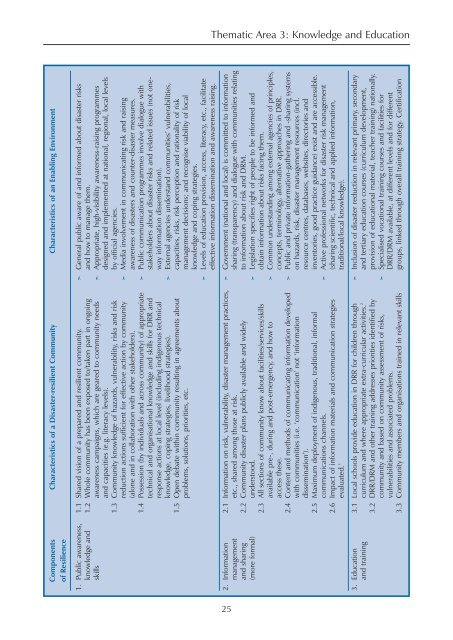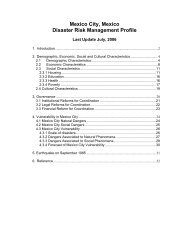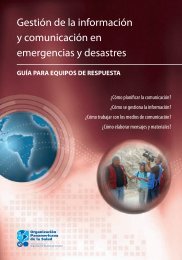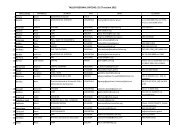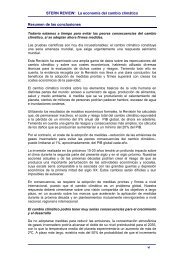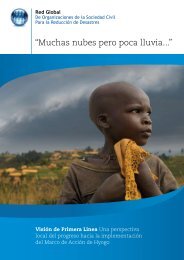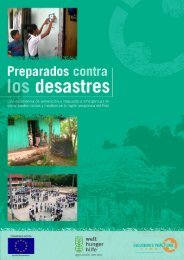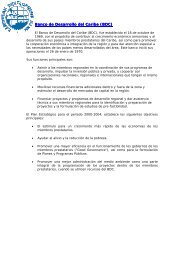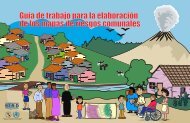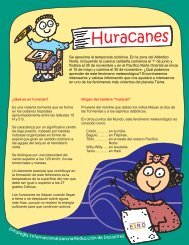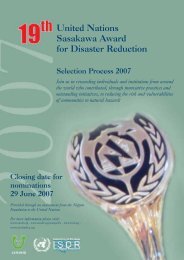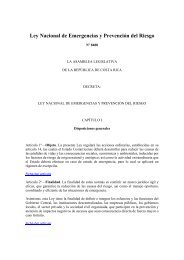Characteristics of a Disaster-resilient Community A ... - PreventionWeb
Characteristics of a Disaster-resilient Community A ... - PreventionWeb
Characteristics of a Disaster-resilient Community A ... - PreventionWeb
You also want an ePaper? Increase the reach of your titles
YUMPU automatically turns print PDFs into web optimized ePapers that Google loves.
Thematic Area 3: Knowledge and EducationComponents <strong>Characteristics</strong> <strong>of</strong> a <strong>Disaster</strong>-<strong>resilient</strong> <strong>Community</strong> <strong>Characteristics</strong> <strong>of</strong> an Enabling Environment<strong>of</strong> Resilience1. Public awareness, 1.1 Shared vision <strong>of</strong> a prepared and <strong>resilient</strong> community. ➣ General public aware <strong>of</strong> and informed about disaster risksknowledge and 1.2 Whole community has been exposed to/taken part in ongoing and how to manage them.skills awareness campaigns, which are geared to community needs ➣ Appropriate, high-visibility awareness-raising programmesand capacities (e.g. literacy levels). designed and implemented at national, regional, local levels1.3 <strong>Community</strong> knowledge <strong>of</strong> hazards, vulnerability, risks and risk by <strong>of</strong>ficial agencies.reduction actions sufficient for effective action by community ➣ Media involvement in communicating risk and raising(alone and in collaboration with other stakeholders). awareness <strong>of</strong> disasters and counter-disaster measures.1.4 Possession (by individuals and across community) <strong>of</strong> appropriate ➣ Public communication programmes involve dialogue withtechnical and organisational knowledge and skills for DRR and stakeholders about disaster risks and related issues (not oneresponseactions at local level (including indigenous technical way information dissemination).knowledge, coping strategies, livelihood strategies). ➣ External agencies understand communities’ vulnerabilities,1.5 Open debate within community resulting in agreements about capacities, risks, risk perception and rationality <strong>of</strong> riskproblems, solutions, priorities, etc. management decisions; and recognise viability <strong>of</strong> localknowledge and coping strategies.➣ Levels <strong>of</strong> education provision, access, literacy, etc., facilitateeffective information dissemination and awareness raising.2. Information 2.1 Information on risk, vulnerability, disaster management practices, ➣ Government (national and local) is committed to informationmanagement etc., shared among those at risk. sharing (transparency) and dialogue with communities relatingand sharing 2.2 <strong>Community</strong> disaster plans publicly available and widely to information about risk and DRM.(more formal) understood. ➣ Legislation specifies right <strong>of</strong> people to be informed and2.3 All sections <strong>of</strong> community know about facilities/services/skills obtain information about risks facing them.available pre-, during and post-emergency, and how to ➣ Common understanding among external agencies <strong>of</strong> principles,access these. concepts, terminology, alternative approaches in DRR.2.4 Content and methods <strong>of</strong> communicating information developed ➣ Public and private information-gathering and -sharing systemswith communities (i.e. ‘communication’ not ‘information on hazards, risk, disaster management resources (incl.dissemination’). resource centres, databases, websites, directories and2.5 Maximum deployment <strong>of</strong> indigenous, traditional, informal inventories, good practice guidance) exist and are accessible.communications channels. ➣ Active pr<strong>of</strong>essional networks for disaster risk management2.6 Impact <strong>of</strong> information materials and communication strategies (sharing scientific, technical and applied information,evaluated. 1 traditional/local knowledge).3. Education 3.1 Local schools provide education in DRR for children through ➣ Inclusion <strong>of</strong> disaster reduction in relevant primary, secondaryand training curriculum and where appropriate extra-curricular activities. 2 and tertiary education courses (curriculum development,3.2 DRR/DRM and other training addresses priorities identified by provision <strong>of</strong> educational material, teacher training) nationally.community and based on community assessment <strong>of</strong> risks, ➣ Specialised vocational training courses and facilities forvulnerabilities and associated problems. DRR/DRM available, at different levels and for different3.3 <strong>Community</strong> members and organisations trained in relevant skills groups, linked through overall training strategy. Certification25


